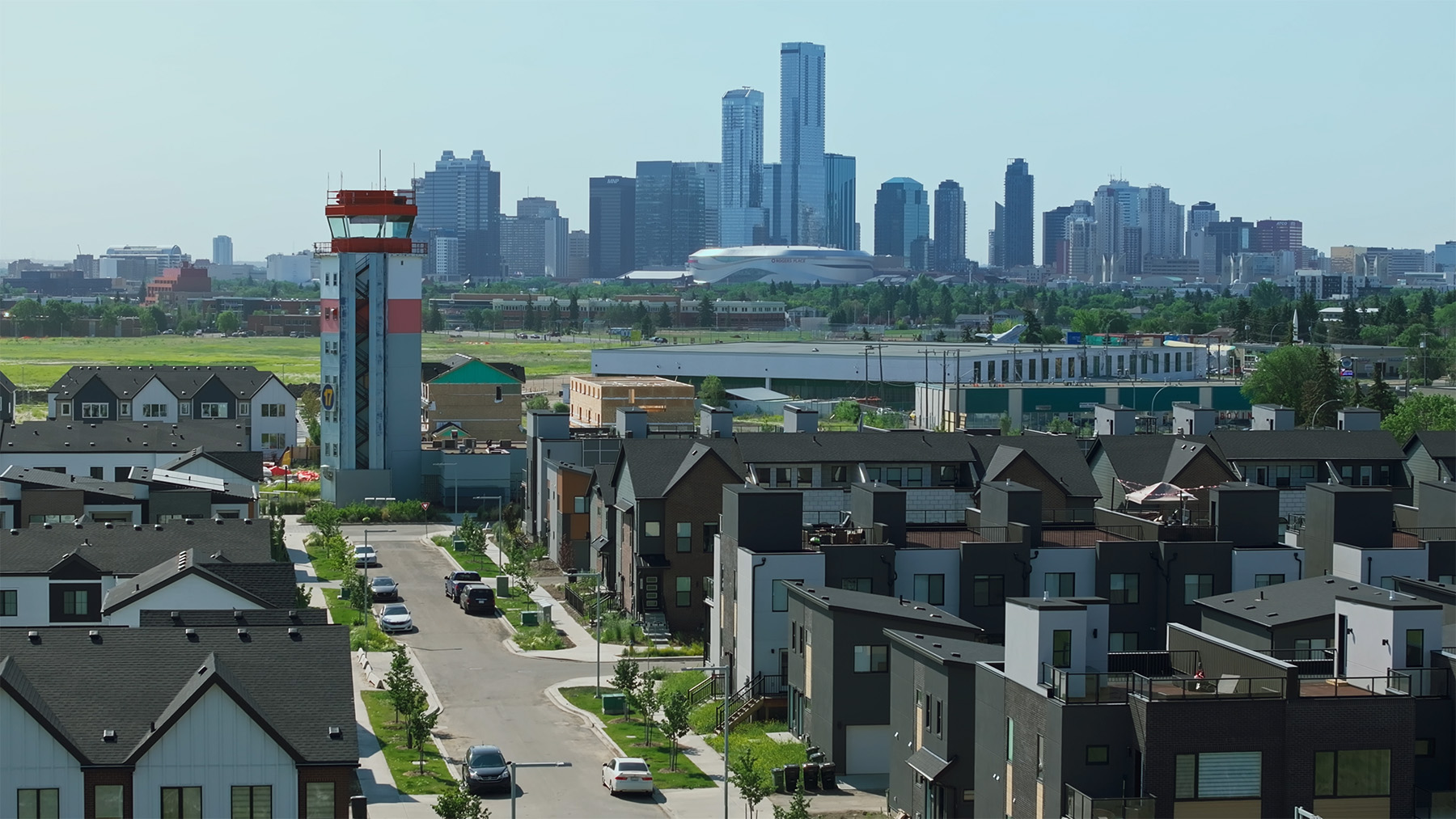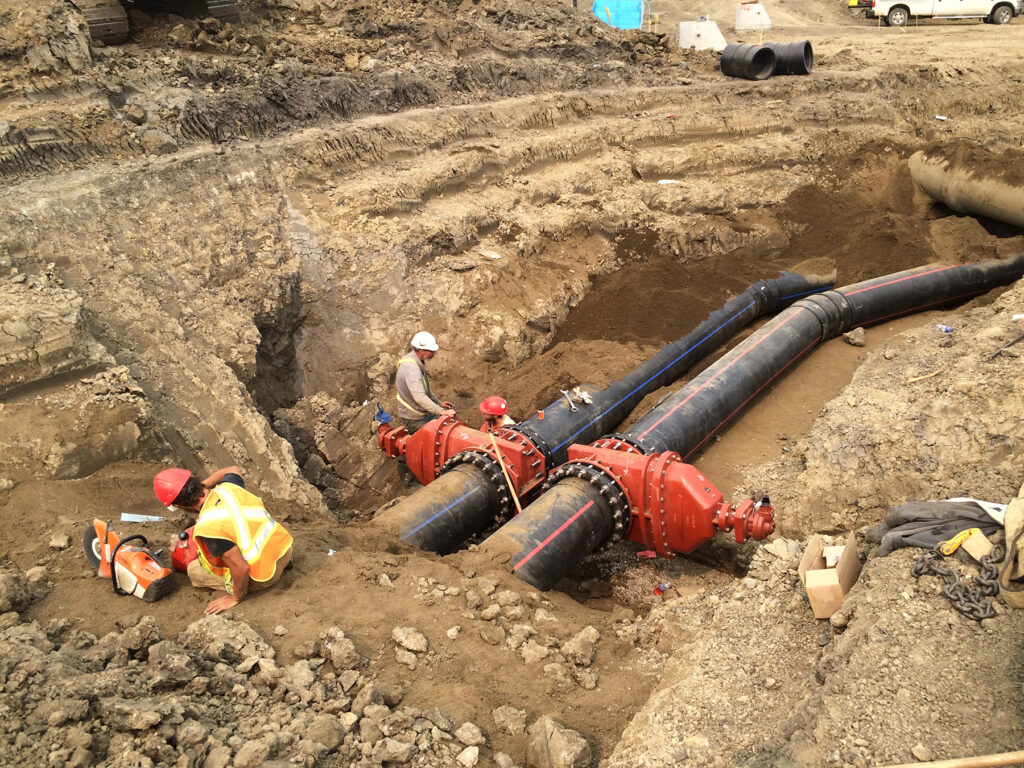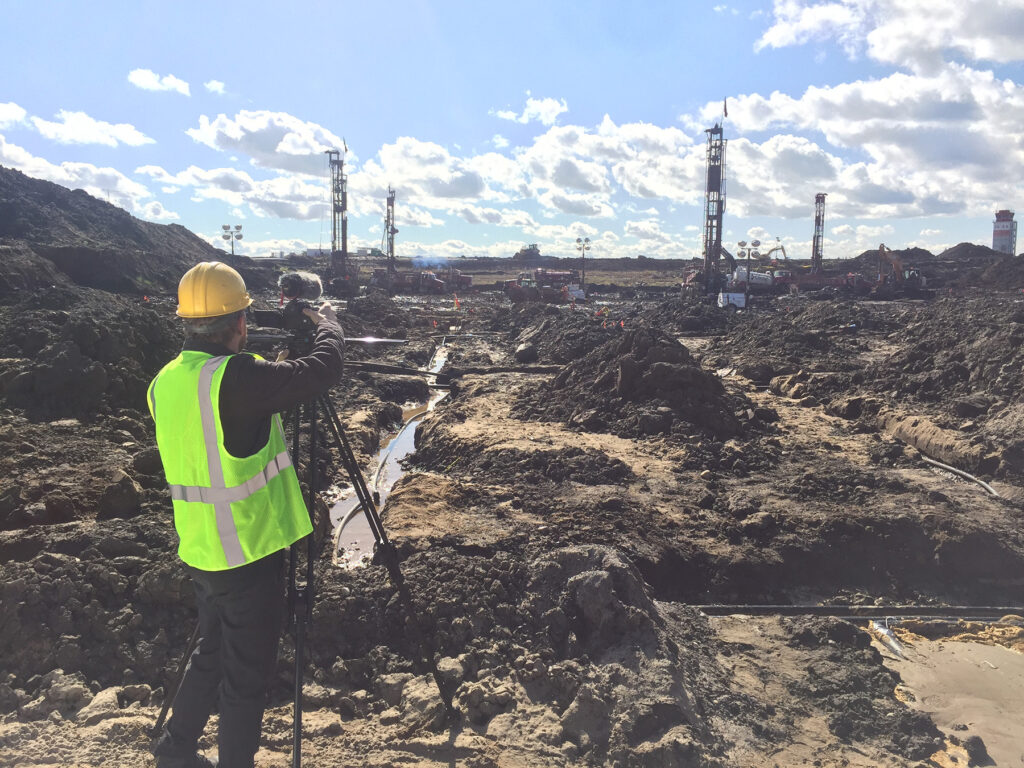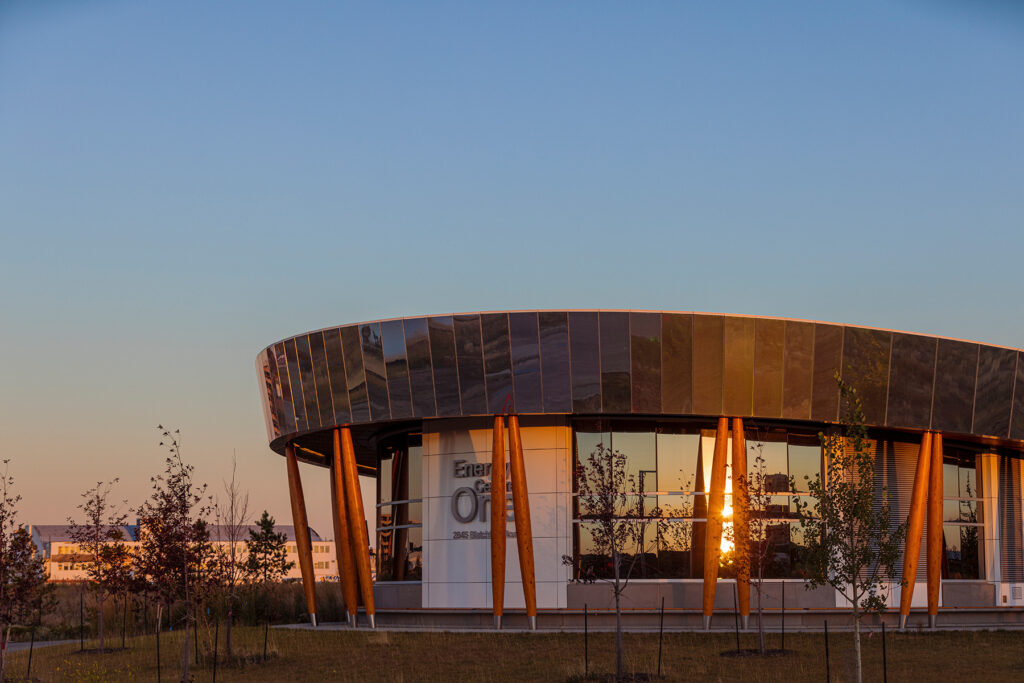
Blatchford in the foreground, with the Edmonton skyline behind. Image credit: Blatchford Redevelopment Office.
|
Quick stats:
|
“We are five years in, and it works fantastic. We have not had a single challenge on anything operational.”
Christian Felske, Director of Renewable Energy Systems, City of Edmonton
A New Vision for Blatchford
In 2008, Edmonton’s City Council voted to close the Edmonton City Centre airport and redevelop the 536-acre site into a “sustainable community powered entirely by renewable energy” for up to 30,000 Edmontonians to live, work and learn. It was a vision that was ambitious at the time, explains Christian Felske, Director of Renewable Energy Systems for the City of Edmonton, and remains ahead of the curve today.
The airport ceased operations in 2013. Meanwhile, the City refined its redevelopment strategy for this area, known as Blatchford. While most buildings in Alberta rely on natural (methane) gas for heating and air conditioners for cooling, Edmonton’s City Council selected a geoexchange network as an efficient, renewable alternative for Blatchford. In 2017, Edmonton established a new municipal utility, Blatchford Renewable Energy, to manage the system. By 2019, the new utility was operational, and in 2020, it began delivering heating and cooling to its first customers.
Meet Blatchford’s System
Felske describes Blatchford’s system as a 5th-generation district energy network serving a mix of commercial, institutional, and residential buildings. To avoid confusion, the system is described as “geoexchange” rather than “geothermal,” which is a term that residents tend to associate with deep boreholes, Felske explains.
Geoexchange boreholes warm water to temperatures between 10-20°C (50–68°F). A two-pipe, ambient-temperature ground loop distributes this water to buildings, each equipped with heat pumps to extract the thermal energy and upgrade its temperature to the desired warmth. There are also plans to add sewer heat exchange as another renewable energy source to the system.
Blatchford’s current primary energy sources are 570 shallow boreholes, spaced about six meters (20 feet) apart and extending about 150 meters (500 feet) deep. These connect to the development’s energy center. Inside, two 1-MW heat pump units “upgrade” the heat for the ground loop, ensuring efficiency in Alberta’s cold winters and increasingly hotter summers.
The system has multiple resiliency measures. There is a natural gas boiler as a backup to maintain the temperature of the loop if needed. A diesel-powered backup generator provides resilience in case of a power outage, while individual homes also have built-in backup systems.
Cold-weather peaking is a key consideration given the region’s extreme temperatures. While the renewable capacity is currently sufficient to handle peak demand for the homes there—even in -50°C (-122°F) conditions—the overall system was not designed for peak loads at full buildout. As the system scales, additional energy sources will be required to maintain ambient loop temperatures. Currently, natural gas is a peaking solution for short durations, but community opposition to gas—and the city’s desire to transition Edmonton’s energy use to greener sources where possible—has sparked research into renewable alternatives.

Workers run pipes during construction in Blatchford. Image credit: Blatchford Redevelopment Office.
Legal Framework, Connection Mandates, and Integrating with Utilities
Edmonton had the authority to create Blatchford Renewable Energy under the Municipal Government Act, which allows municipalities to operate heating utilities. As a municipal utility, Blatchford Renewable Energy is regulated by the Edmonton City Council, which reviews all decisions regarding capital and operating costs, rates, and governance. The provincial Utilities Commission does not oversee daily operations, but it does have the authority to intervene should Blatchford customers have problems or complaints.
Blatchford Renewable Energy’s bylaw provides a powerful tool to mandate customer connection—any developer who builds in Blatchford must connect to the geothermal system. Builders may apply for an exemption if they can achieve net-zero carbon performance without using the system, but the majority choose to join the system, Felske says.
The City of Edmonton has a natural gas franchise agreement with ATCO Energy, and the City does not have the authority to eliminate natural gas entirely, Felske says. ATCO chose to expand service to Blatchford, and some homeowners or developers opt to install gas stoves or BBQ hookups. As a result, occupants in those buildings receive three separate utility bills: one from their electricity provider, one from ATCO, and one from Blatchford Renewable Energy.

Building Blatchford’s geoexchange field. Image credit: Blatchford Redevelopment Office.
Financing, Customers, and Revenue
From the start, Felske says, the City Council recognized that additional funding was needed to support Blatchford’s development and its new utility. There is no tax levy associated with the utility, and capital expenditures to date have been primarily funded through self-supporting tax-guaranteed debt. To help close the gap, the utility is actively pursuing federal and provincial grants – and received a $23.7 million Government of Canada grant last year to support expansion of the system as this growing community’s capacity needs increase.
City Council mandated that Blatchford residents should not pay more for their energy than residents using conventional gas and electricity in Edmonton, while allowing utilities to account for their maintenance costs. While this policy promotes adoption of renewable heating and cooling, it also requires Blatchford Renewable Energy to seek out other funding sources. Felske points out the importance of innovative financing mechanisms for ambitious renewable energy projects like Blatchord; although Edmonton’s City Council was prepared to take the financial leap while the network scales up, a no-interest loan at the outset would be a large help to similar projects.
Currently, there are over 130 connections to the geoexchange network (in the community’s multi-unit developments, one connection can support multiple homes). Expanding the customer base remains the most effective way to achieve ultimate financial sustainability. External factors, including the COVID-19 pandemic, slowed initial growth, but customer adoption is now increasing, says Felske.
The utility’s revenue derives from two main streams:
- Connection fees: A one-time fee charged when buildings connect to the system. It is calculated based on square footage and number of units. The fee is fixed for a full year and reviewed annually.
- Rates: A combination of fixed and variable charges blended at a ratio of 65–35, reflecting the capital-intensive nature of the system. Rates are also fixed for a full year and approved by the City Council on an annual basis.

Energy Centre One: The nucleus of the geoexchange system. Image credit: Blatchford Redevelopment Office.
Customer Reception
Blatchford residents “love” the system, Felske says. Residents that make their homes in Blatchford are attracted to its sustainability ethos and take pride in the community. Remarkably for a province with a history of oil and gas exploration, says Felske, some residents have requested a ban on using natural gas peaker plants in Blatchford. (While the geoexchange system has provisions for natural gas backup and peaking, it has not been needed so far, as the utility’s load is still growing.)
The city and utility communicates with residents through regular newsletters, community events, and guided tours of the district energy system. Significant effort goes into maintaining a strong relationship with customers and community members. Like any city initiative, there is sometimes skepticism and criticism of City Council decisions on rates, Felske says. However, the continued support from local officials indicates the overall positive feedback from constituents.

Separated bike lanes, a fruit orchard, rain cisterns, and walking trails all contribute to Blatchford’s sustainable ethos. Image credit: Blatchford Redevelopment Office.
Future and Scaling
“We are five years in, and it works fantastic,” says Felske. “We have not had a single challenge on anything operational.”
Canada has many municipal district energy utilities in its cities, and at full buildout, Blatchford is anticipated to have one of the country’s largest ambient-temperature district energy systems—if not the largest. Felske would like to see more of these utilities. While Edmonton took the lead in developing the district energy system, Blatchford Renewable Energy’s goal is to establish the infrastructure, prove its viability, and create conditions for a future transition where a larger utility or private geothermal operator can more easily scale the system, Felske explains.
With a national focus on energy affordability, the puzzle that municipal utilities must solve is finding attractive financing and funding options, he says.
Ultimately, “my advice is: Build more,” says Felske. “I think these are extremely important systems.”
Thank you to Christian Felske and Blatchford Redevelopment Office for your contributions to this case study.
